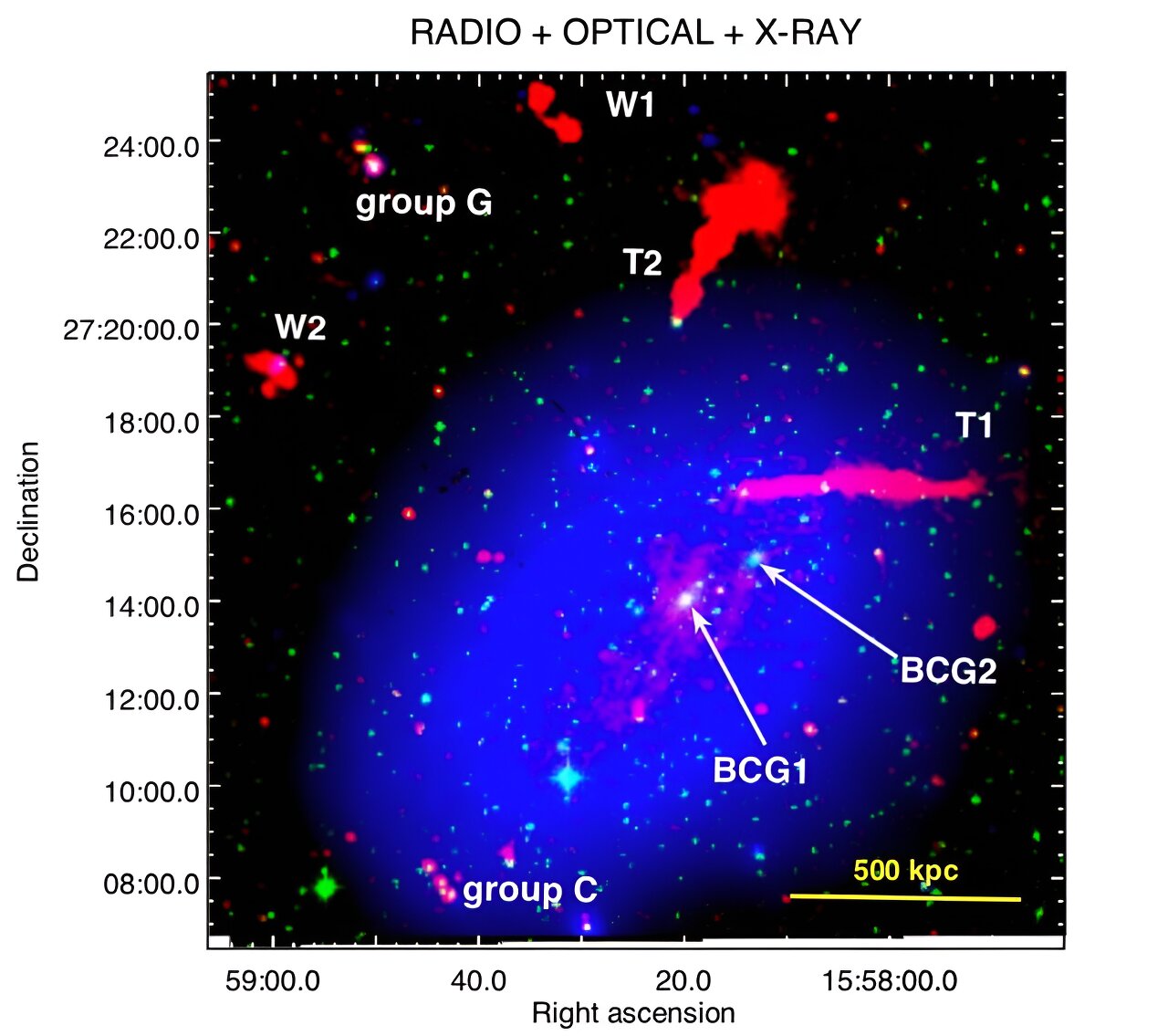A recent discovery by a team of international astronomers has opened a new window into the enigmatic structures that reside within massive galaxy clusters.
Using the MeerKAT radio telescope, they have successfully detected a new radio halo in a galaxy cluster known as ACT-CL J0329. This colossal object lies an impressive 1.23 times farther away from Earth compared to the previously observed farthest radio halo. This groundbreaking finding, reported in a research paper published on arXiv on April 5, 2024, deepens our understanding of these colossal objects and the energetic processes occurring at the heart of galaxy clusters.
Demystifying Radio Halos: Faint Giants Within Galaxy Clusters
Galaxy clusters, the most massive structures in the observable universe, are cosmic metropolises containing thousands of galaxies bound together by gravity. Radio halos are vast regions of faint radio emission that envelop the central regions of these clusters. Despite their enormous size, spanning millions of light-years, radio halos are notoriously difficult to detect due to their low surface brightness, particularly at high frequencies. This is where powerful telescopes like MeerKAT come into play. MeerKAT’s exceptional sensitivity at lower frequencies allows astronomers to peer through the faint glow and unveil these hidden giants.
MeerKAT Uncovers a Record-Breaking Radio Halo
The research team, led by Sinenhlanhla Precious Sikhosana from the University of KwaZulu-Natal in South Africa, utilized the MeerKAT telescope as part of the MeerKAT Massive Distant Cluster Survey (MMDCS) to investigate ACT-CL J0329. This behemoth galaxy cluster boasts a mass exceeding a staggering 970 trillion times that of our Sun. Their observations at lower L-band and UHF-band frequencies revealed a faint but extensive radio emission emanating from the cluster’s center, stretching over an astounding 3.59 million light-years. This signature confirmed the presence of a radio halo, making it the farthest one ever detected at such a high redshift, pushing the boundaries of our knowledge about these cosmic structures.
Properties of the Newly Discovered Radio Halo and its Implications
Analysis of the MeerKAT data yielded intriguing details about the newfound radio halo. It exhibits a smooth, symmetrical structure, mirroring the distribution of hot gas within the cluster’s intracluster medium (ICM). Interestingly, the halo’s radio brightness is comparable to those observed in nearby galaxy clusters. This unexpected similarity suggests a surprisingly rapid amplification of magnetic fields within ACT-CL J0329 despite its vast distance, raising questions about the mechanisms at play in these distant environments. The radio power of the halo was estimated to be 4.4 YW/Hz, while its integrated spectral index, a measure of the distribution of radio waves across different frequencies, was calculated to be 1.3.
Beyond the Detection: Unveiling Complex Energy Dissipation
The discovery of this record-breaking radio halo goes beyond simply identifying a new structure. The spectral index map of ACT-CL J0329 showcases intriguing variations, with steeper values concentrated in the eastern region. This finding suggests that the energy dissipation within the halo volume might not be uniform. Imagine a giant cauldron of swirling hot gas; the newfound variations hint at potential turbulence or localized areas of enhanced energy release within the halo. Further investigation with more powerful telescopes and detailed simulations are needed to unravel these complexities and understand the physical processes governing energy transfer within these vast cosmic objects.
The Significance of Radio Halo Discoveries: A Window into Galaxy Cluster Evolution
The detection of this record-breaking radio halo in ACT-CL J0329 is a significant leap forward in our understanding of galaxy clusters and the evolution of magnetic fields within them. By studying these faint giants, astronomers can gain valuable insights into the energetic processes occurring in the hottest and most massive regions of the universe.

These energetic environments are thought to play a crucial role in the evolution of galaxies within the cluster, potentially regulating star formation and shaping the overall structure of these massive cosmic systems. As technology advances and telescopes like MeerKAT continue to explore the cosmos with ever-increasing sensitivity, we can expect even more fascinating discoveries about radio halos and the role they play in the grand story of galaxy clusters.
This newfound radio halo, along with future discoveries, will undoubtedly illuminate our understanding of the formation and evolution of these enigmatic structures and the energetic processes that govern the universe’s largest cosmic structures.
The discovery of a massive radio halo in the distant galaxy cluster ACT-CL J0329 offers a glimpse into the energetic processes shaping the universe. This finding, made possible by the MeerKAT telescope, expands our understanding of galaxy clusters and their evolution. As we unravel the mysteries of these cosmic giants, we move closer to unlocking the secrets of the universe’s largest structures.



















